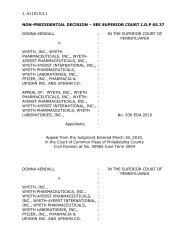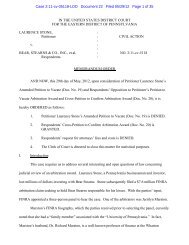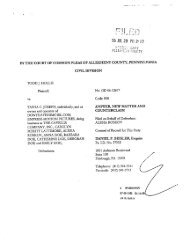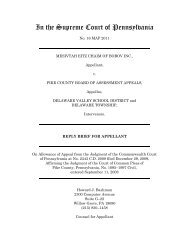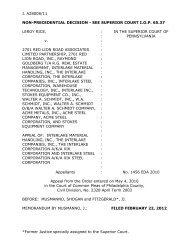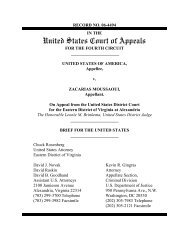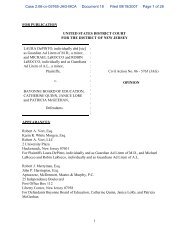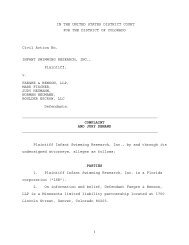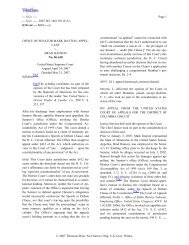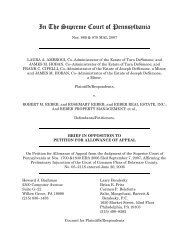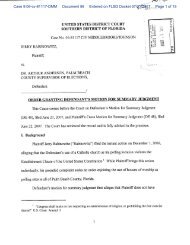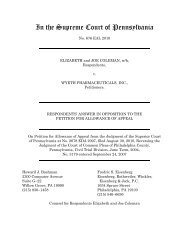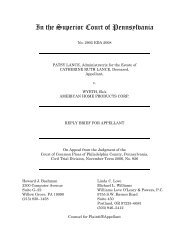petition for rehearing en banc - How Appealing
petition for rehearing en banc - How Appealing
petition for rehearing en banc - How Appealing
Create successful ePaper yourself
Turn your PDF publications into a flip-book with our unique Google optimized e-Paper software.
def<strong>en</strong>dants guilty solely due to honest services fraud. Because def<strong>en</strong>dants’ Rule 54 submis-<br />
sions already explained that the governm<strong>en</strong>t’s approach (now embraced by the panel) is in-<br />
consist<strong>en</strong>t with Supreme Court authority and the law of other circuits, only this Court <strong>en</strong><br />
<strong>banc</strong>, or the Supreme Court in due course, can now correct the panel’s errors.<br />
ARGUMENT<br />
The Supreme Court already ruled in this case that the jury instructions on honest-services<br />
fraud authorized conviction <strong>for</strong> conduct that is not a crime. That violation of the Due Proc-<br />
ess Clause of the Fifth Am<strong>en</strong>dm<strong>en</strong>t, see e.g., Carella v. Cali<strong>for</strong>nia, 491 U.S. 263, 265 (1989)<br />
(citing In re Winship, 397 U.S. 358, 364 (1970)), requires the governm<strong>en</strong>t to prove beyond a<br />
reasonable doubt that the jury in fact convicted on a proper basis—i.e., that the jury actually<br />
“has found, in Winship’s words, ‘every fact necessary’ to establish every elem<strong>en</strong>t of the of-<br />
f<strong>en</strong>se beyond a reasonable doubt.” Carella, 491 U.S. at 266 (citations omitted). The issue is<br />
not whether “the verdict could have be<strong>en</strong> the same without” the error, or whether “there was<br />
evid<strong>en</strong>ce suffici<strong>en</strong>t to support the verdict indep<strong>en</strong>d<strong>en</strong>tly of the [error’s] effect.” Yates, 500<br />
U.S. at 406-07 (emphasis added); id. at 407 & n. 7. Ev<strong>en</strong> with respect to non-constitutional<br />
errors, where the governm<strong>en</strong>t’s burd<strong>en</strong> of persuasion is far lighter, it has long be<strong>en</strong> the rule<br />
that “it is not the appellate court’s function to determine guilt or innoc<strong>en</strong>ce.” Kotteakos v.<br />
United States, 328 U.S. 750, 763-64 (1946); Rose, 478 U.S. 582 n.11 (“[T]he determination<br />
of guilt or innoc<strong>en</strong>ce, according to the standard of proof required by Winship and its prog<strong>en</strong>y,<br />
is <strong>for</strong> the jury rather than the court”). Thus, an error “cannot be r<strong>en</strong>dered harmless by the<br />
fact that, giv<strong>en</strong> the evid<strong>en</strong>ce, no reasonable jury would have found otherwise. To allow the<br />
error to be cured in this fashion would be to disp<strong>en</strong>se with trial by jury.” Cali<strong>for</strong>nia v. Roy,<br />
519 U.S. 2, 7 (1996) (Scalia & Ginsburg, JJ., concurring); see also Rose, 478 U.S. at 578<br />
(“the error in such a case is that the wrong <strong>en</strong>tity judged the def<strong>en</strong>dant guilty”); United States<br />
v. Martin Lin<strong>en</strong> Supply Co., 430 U.S. 564, 572-73 (1977).<br />
4



